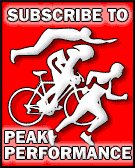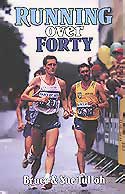
New: The Blog

Webmasters!:
Free training advice
for your readers »




New book for over 40s by the Tullohs
Click here for details.
Click here for details.

Gary O'Donovan explains why high-intensity exercise is the best bet for training and weight loss The concept of the fat burning zone is highly attractive to the exercise enthusiasts of today, many of whom are more interested in weight loss than the pursuit of fitness. Training zone charts adorn the walls of fitness centres up and down the country, and body-conscious exercisers religiously adhere to the recommended limits for exercising heart rates.
However, while moderate-intensity exercise may be appropriate for beginners, athletes and serious fitness enthusiasts should avoid the fat burning zone like the plague, except on light days or recovery runs - unless they want to see a decline in energy expenditure and fitness.
What is the fat burning zone?
Although the origin of the fat
burning zone (FBZ) concept is unknown, the fitness industry probably
seized on the following key facts:
1. low- to moderate-intensity exercise is fuelled predominantly by fat;
2. an optimum fat burning rate has been identified (Figure 1) at 65% of
maximal oxygen consumption (VO2 max) - the body's ability to take on
board and use oxygen during exhaustive exercise.
Because fitness centres don't usually own the gas analysers that measure VO2 max directly, the FBZ is instead located indirectly, with a heart rate monitor, at 60-70% of age-predicted maximum heart rate (1). Age-predicted maximum heart rate is derived from the formula 220 - age, giving a 25-year-old, for example, a FBZ of 117-136 beats/min. The use of this formula involves two considerable assumptions:
* that exercise heart rate can be used to predict oxygen consumption and
* that maximum heart rate is the same for everyone of a given age.
These assumptions will be questioned later.
Exercise intensity and fuel use
Supporters of the FBZ
advocate a reduction in effort in return for the promise of increased
fat metabolism. However, fitness professionals should receive the
suggestion that such moderate-intensity exercise will improve fitness
or body composition with scepticism. Inherently we are aware that
performance becomes less efficient as exercise intensity increases and
that, if exercise duration is held constant, an individual will burn
more calories with high-intensity work .
At the start of exercise (regardless of the intensity), a cascade of biochemical events is initiated by neurological stimulation. Glycolysis (an anaerobic means of ATP/energy provision, fuelled by carbohydrate) is primed by hormones and neurotransmitters to take over from phosphagen-mediated energy sources (2). Thereafter, if the exercise is of a low- to moderate-intensity, energy demands are met increasingly by fat in the form of muscle triglycerides and plasma free fatty acids. If the exercise is of a high intensity, energy from carbohydrate-derived fuels predominates (3).
This shift from fat to carbohydrate oxidation during high-intensity exercise is essential to increase both the magnitude and the rate of energy release. Muscle can extract more energy per litre of oxygen consumed from carbohydrate than from fat. Table 1 shows that more than 5 kcal of energy are liberated per litre of oxygen consumed if carbohydrate alone is oxidised. On the other hand, the mixture of carbohydrate and fat oxidised during moderate intensity exercise releases only 4.86 kcal per litre of oxygen. Thus, although oxygen uptake may be a limiting factor, the greater energy demands of high-intensity exercise can be met. Unfortunately, though, the 'fast-twitch' muscle fibres recruited in high-intensity work are relatively inefficient and bring about the decline in power associated with intensive exercise.
The myth of the fat burning zone
We all know that the only
reliable route to weight loss is to take in less energy from food than
we expend in activity - regardless of the fuel for that activity. We
also know that energy expenditure increases in line with exercise
intensity: Table 1 shows that 404 kcals of energy are expended in 20
minutes of very high-intensity exercise, compared with only 244 kcals
in moderate-intensity exercise performed for the same duration.
Consider this also: Figure 1 shows that at 25% of maximum oxygen
consumption, the demands of exercise are met entirely by fat. However,
the minimal calorie cost of such exercise is unlikely to make any
meaningful contribution to daily energy expenditure. Thus it is clear
how the principles of substrate metabolism have been misinterpreted:
when it comes to weight loss it is not the proportion of each fuel
metabolised but the total calorie expenditure that is crucial.
The real fat burning zone
There are two components involved
in the total energy cost of exercise: first, the energy cost of the
activity itself, which accounts for most of the caloric expenditure;
secondly, the energy expended in recovery while the metabolic rate
remains elevated above resting levels. This 'excess postexercise oxygen
consumption' (EPOC) is fuelled by fat. Intriguingly, not all exercise
is sufficient to bring about a meaningful EPOC: it is generally agreed
that such exercise must be carried out at more than 70% of VO2 max (4).
Although this mechanism is not entirely understood, it seems that the
metabolic disturbance of exercise determines the magnitude and duration
of EPOC.
In order to recover from exercise, the body undertakes several active (energy-consuming) processes for up to an hour afterwards: phosphate is reunited with creatine and ADP; haemoglobin and myoglobin (oxygen-carrying pigment within the muscle) are resaturated with oxygen; lactate is oxidised or resynthesised to glycogen; circulation and breathing increase. In addition, the return to homeostasis following high-intensity exercise is further delayed by the demands of glycogen resynthesis and increased hormonal activity. Interestingly, in the glycogen-depleted state, this prolonged EPOC period is fuelled by lipid as blood glucose is used to replace muscle glycogen (3).
This postexercise fat burning zone barely exists after moderate-intensity exercise. In a 1992 study, participants cycling for 80 minutes at 29% of VO2 max experienced an elevated oxygen consumption (and energy expenditure) for 0.3 hours, compared with 3.3 hours for those exercising at 50% of VO2 max and 10.5 hours for those at 75% (4).
Clearly, the calorific value of EPOC has implications for those seeking to reduce body weight. Indeed, after 20 minutes of high intensity exercise (70% VO2max), Sedlock et al (5) observed an EPOC of approximately 30 kcal and calculated that if such exercise were performed five times a week for 52 weeks, the EPOC period alone would amount to 7,800 kcal or the energy equivalent of approximately 1 kg fat.
The fat burning zone and the
training response
Trained
individuals are better able to burn fat during submaximal exercise than
their untrained counterparts (3). This adaptation delays the fatigue
associated with the depletion of muscle glycogen - also known as
'hitting the wall'. There is also evidence to suggest that resting
metabolic rate (RMR) is increased with endurance training. For example,
Lawson et al (6) noted a 13% increase in the RMR of six subjects
following 10 weeks of training (17 min 3 times/week during the first
week, progressing to 77 min 4 times/week by week 10). Conversely, when
exercise training is stopped for as little as three days, RMR has been
shown to decline by 7% (7). Since RMR is the primary component of daily
energy expenditure, elevation of metabolic rate with exercise may be an
invaluable tool in weight loss. These training responses are muted with
moderate intensity exercise performed within the FBZ.
Exercisers and personal trainers alike should also be aware that the FBZ is identified from an unsubstantiated prediction equation. The research which gave rise to the formula for maximum heart rate (220 minus age in years) has never been published (8). Moreover, it assumes that the maximal heart rate for a particular age is uniform. Given the considerable individual variation in maximum heart rate (9), this assumption will inevitably result in some people overtraining while others undertrain.
Equally invalid is the assumption that percentage maximal oxygen uptake and percentage maximum heart rate are directly comparable. Oxygen uptake scores are approximately 5-10% lower at any given intensity than those predicted using maximum heart rate values. An intensity of 65% maximum heart rate, therefore, is likely to elicit only 55-60% of maximal oxygen consumption. Crucially, this may not reach the lower threshold for improvements in aerobic fitness of 60% VO2 max set down by the American College of Sports Medicine in 1995 (10).
In conclusion...
* The fat burning zone is not the optimum exercise intensity for weight management, fitness or performance.
* Although a greater proportion of energy is derived from fat within the
FBZ, total energy expenditure is greater with high-intensity exercise.
* It is total energy expenditure, regardless of the source, that is
paramount for achieving sensible weight loss via negative energy
balance.
* Energy expenditure is greater both during and after high intensity exercise.
* The moderate-intensity FBZ is unlikely to bring about a prolonged excess postexercise oxygen consumption (EPOC).
* The prolonged EPOC component is fuelled by fat and may add an additional 30+ kcal to each workout.
* It is unlikely that aerobic fitness will be maintained or improved within the FBZ.
* Training within the FBZ will not bring about the preferential
metabolism of fat during exercise or higher resting metabolic rate
enjoyed by endurance-trained subjects.
* The variation in max heart rate undermines the use of prediction equations in exercise prescription.
Talk about this article in our Online Community